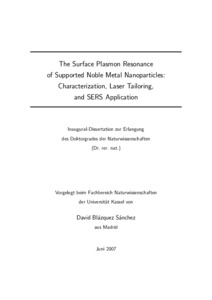| dc.date.accessioned | 2007-07-20T10:59:05Z | |
| dc.date.available | 2007-07-20T10:59:05Z | |
| dc.date.issued | 2007-07-20T10:59:05Z | |
| dc.identifier.uri | urn:nbn:de:hebis:34-2007072019004 | |
| dc.identifier.uri | http://hdl.handle.net/123456789/2007072019004 | |
| dc.format.extent | 28094335 bytes | |
| dc.format.mimetype | application/pdf | |
| dc.language.iso | eng | |
| dc.rights | Urheberrechtlich geschützt | |
| dc.rights.uri | https://rightsstatements.org/page/InC/1.0/ | |
| dc.subject | Nanoparticles | eng |
| dc.subject | Surface Plasmon Polariton | eng |
| dc.subject | Laser | eng |
| dc.subject | SERS | eng |
| dc.subject | Gold | eng |
| dc.subject | Silver | eng |
| dc.subject.ddc | 500 | |
| dc.subject.ddc | 530 | |
| dc.title | The Surface Plasmon Resonance of Supported Noble Metal Nanoparticles: Characterization, Laser Tailoring, and SERS Application | eng |
| dc.type | Dissertation | |
| dcterms.abstract | This work deals with the optical properties of supported noble metal nanoparticles, which are dominated by the so-called Mie resonance and are strongly dependent on the particles’ morphology. For this reason, characterization and control of the dimension of these systems are desired in order to optimize their applications. Gold and silver nanoparticles have been produced on dielectric supports like quartz glass, sapphire and rutile, by the technique of vapor deposition under ultra-high vacuum conditions. During the preparation, coalescence is observed as an important mechanism of cluster growth. The particles have been studied in situ by optical transmission spectroscopy and ex situ by atomic force microscopy. It is shown that the morphology of the aggregates can be regarded as oblate spheroids. A theoretical treatment of their optical properties, based on the quasistatic approximation, and its combination with results obtained by atomic force microscopy give a detailed characterization of the nanoparticles. This method has been compared with transmission electron microscopy and the results are in excellent agreement. Tailoring of the clusters’ dimensions by irradiation with nanosecond-pulsed laser light has been investigated. Selected particles are heated within the ensemble by excitation of the Mie resonance under irradiation with a tunable laser source. Laser-induced coalescence prevents strongly tailoring of the particle size. Nevertheless, control of the particle shape is possible. Laser-tailored ensembles have been tested as substrates for surface-enhanced Raman spectroscopy (SERS), leading to an improvement of the results. Moreover, they constitute reproducible, robust and tunable SERS-substrates with a high potential for specific applications, in the present case focused on environmental protection. Thereby, these SERS-substrates are ideally suited for routine measurements. | eng |
| dcterms.accessRights | open access | |
| dcterms.creator | Blázquez Sánchez, David | |
| dc.contributor.corporatename | Kassel, Universität, FB 18, Naturwissenschaften, Institut für Physik | |
| dc.contributor.referee | Träger, Frank (Prof. Dr.) | |
| dc.contributor.referee | Matzdorf, René (Prof. Dr.) | |
| dc.date.examination | 2007-07-18 | |

